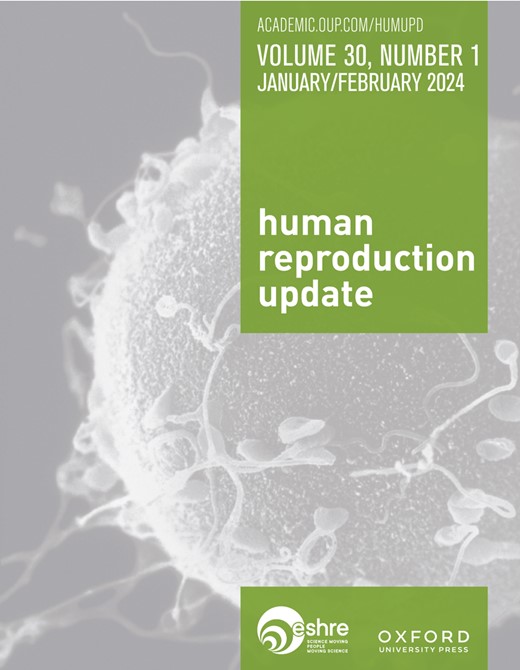胚胎代谢作为一种新的无创着床前试验:人废胚胎培养基(SECM)的营养翻转和代谢组学分析
IF 16.1
1区 医学
Q1 OBSTETRICS & GYNECOLOGY
引用次数: 0
摘要
背景:单胚胎移植是全球范围内推荐的IVF治疗方法。因此,对更好的胚胎选择的需求日益增长。此外,从形态学和遗传学的角度来看,废胚培养基(SECM)的营养摄取/释放和代谢组谱被认为是无创生物标志物。它们准备好应用于临床目的了吗?目的与原理综述了胚胎代谢分析方法,重点介绍了人类胚胎代谢分析方法。直到2024年11月,Cochrane Library、PubMed和谷歌Scholar检索了同行评议的人类英语研究,其MeSH术语和关键词为:ART、IVF、ICSI、非整倍体、胚胎移植、胚胎选择、培养基、代谢组学、代谢谱、人工智能(AI)、营养物质、碳水化合物、葡萄糖、丙酮酸、乳酸、氨基酸(AAs)、脂肪酸(FAs)和废胚胎培养基(SECM)。同时,检索所有相关文献的参考文献列表。结果:从20个国家收集了49篇原始出版物(1989-2024),其中收集了SECM样本,重点关注着落前胚胎代谢单一生物标志物的能量来源(葡萄糖和丙酮酸),AAs和游离FAs(17项研究)或代谢组学分析(32项研究)。重点是囊胚发育、非整倍性、胚胎性别预测、着床和妊娠结局。11家提供胚胎培养基的大公司主导着市场。他们的培养基的营养成分提出了重大挑战,因为它们通常不公开。在单一生物标志物研究中,8项研究关注葡萄糖和丙酮酸,8项研究关注单独或与葡萄糖或丙酮酸联合使用的AAs及其比例。由于一些研究报告了一些AAs的绝对数量或葡萄糖水平,它们都有可能成为未来临床应用的生物标志物。在代谢组学研究中,几乎所有的研究都报告了定性结果,例如代谢物比率的减少/增加。对于绝对浓度,必须考虑培养基的基础浓度。综上所述,分析了实验设计、平台和结果的所有差异。建立代谢组学研究报告的统一指南和概述SECM实验发表所需的最低信息的具体指南将确保未来的研究提供所有必要和关键的信息。代谢组学研究主要集中在着床和妊娠,而作为第一步,我们更倾向于多组学研究质量好与质量差以及整倍体与非整倍体胚胎的代谢物绝对浓度。遵循这一步骤,这些量化方法可能会导致更令人信服的成功。如果少量的预测性生物标志物被识别出来,就可以为每种培养基开发一种简单、快速、廉价的测试方法,并在生育中心进行临床试验。此外,还需要结合靶向代谢组学对基础培养基成分进行进一步研究。未来可能是由人工智能整合所有主要是非侵入性的信息、组学和其他。审查方案在OSF平台上注册:https://osf.io/mxtbg本文章由计算机程序翻译,如有差异,请以英文原文为准。
Embryo metabolism as a novel non-invasive preimplantation test: nutrients turn over and metabolomic analysis of human spent embryo culture media (SECM)
BACKGROUND Single embryo transfer is globally recommended during IVF treatments. Hence, there is a growing demand for better embryo selection. Additionally, to morphology and genetics, nutrient uptake/release and metabolome profiles in spent embryo culture media (SECM) are proposed as non-invasive biomarkers. Are they ready to be applied for clinical purposes? OBJECTIVE AND RATIONALE We reviewed methods of metabolism analysis for embryos, focusing on human SECM. SEARCH METHODS Until November 2024, the Cochrane Library, PubMed, and Google Scholar were surfed for peer-reviewed English-language studies in the human, with MeSH terms and keywords: ART, IVF, ICSI, aneuploidy, embryo transfer, embryo selection, culture media, metabolome, metabolomics, metabolic profile, artificial intelligence (AI), nutrients, carbohydrates, glucose, pyruvate, lactate, amino acids (AAs), fatty acids (FAs), and spent embryo culture medium (SECM). Also, the reference lists of all relevant articles were searched. OUTCOMES Forty-nine original publications (1989–2024) were found in which SECM samples were collected from 20 countries, focusing on preimplantation embryo metabolism single biomarker(s) of energy sources (glucose and pyruvate), AAs and free FAs (17 studies), or metabolomic analysis (32 studies). Focal points were blastocyst development, aneuploidy, embryo sex prediction, implantation, and pregnancy outcome. Eleven major companies, which supply embryo culture media, dominate the market. Nutrient composition of their culture media presents major challenges because they are not normally disclosed. In single-biomarker(s) studies, eight studies focus on glucose and pyruvate, eight on AAs, both alone and in combination with glucose or pyruvate, and their ratios. Since the absolute quantities of some AAs or glucose levels were reported in some studies, they all have the potential to become future biomarkers for clinical application. In metabolomics studies, almost all studies reported qualitative results, such as decrease/increase or the metabolite ratios. For absolute concentrations, the basal concentrations of the culture media must be considered. In sum, all differences in the experimental design, the platforms, and the results were analyzed. WIDER IMPLICATIONS Establishing a unified guideline for the reporting of metabolomics studies and a specific guideline outlining the minimum information required for SECM experiment publication will ensure that future studies provide all necessary and critical information. The metabolomics studies primarily focused on implantation and pregnancy, whereas we, as a first step, preferred multi-omics studies on absolute concentrations of metabolites of good vs poor quality and euploid vs aneuploid embryos. Following this step, these quantitative approaches might lead to more convincing successes. If small numbers of predictive biomarkers were identified, a simple, rapid, and cheap test could be developed for each medium, clinically performed in the fertility center. Furthermore, further research on basal media ingredients is needed, combined with targeted metabolomics. The future could be an integration of all—primarily non-invasive—information, omics, and other, by AI. REGISTRATION NUMBER The review protocol is registered on the OSF platform: https://osf.io/mxtbg
求助全文
通过发布文献求助,成功后即可免费获取论文全文。
去求助
来源期刊

Human Reproduction Update
医学-妇产科学
CiteScore
28.80
自引率
1.50%
发文量
38
期刊介绍:
Human Reproduction Update is the leading journal in its field, boasting a Journal Impact FactorTM of 13.3 and ranked first in Obstetrics & Gynecology and Reproductive Biology (Source: Journal Citation ReportsTM from Clarivate, 2023). It specializes in publishing comprehensive and systematic review articles covering various aspects of human reproductive physiology and medicine.
The journal prioritizes basic, transitional, and clinical topics related to reproduction, encompassing areas such as andrology, embryology, infertility, gynaecology, pregnancy, reproductive endocrinology, reproductive epidemiology, reproductive genetics, reproductive immunology, and reproductive oncology. Human Reproduction Update is published on behalf of the European Society of Human Reproduction and Embryology (ESHRE), maintaining the highest scientific and editorial standards.
 求助内容:
求助内容: 应助结果提醒方式:
应助结果提醒方式:


